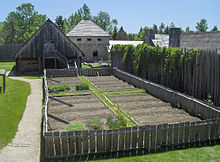Sainte-Marie-au-pays-des-Hurons
Sainte-Marie-au-pays-des-Hurons (English Sainte-Marie among the Hurons , "Our Lady among the Hurons") was a missionary station of the Jesuits in Wendake, the land of the Wyandot , also called Hurons, not far from today's Midland in the Canadian province of Ontario . The station on Georgsbucht , a large bay on Lake Huron , existed from 1639 to 1649 and is the first non-Indian settlement in the province. The station became famous for a massacre of the Hurons by the Iroquois , in which eight Jesuits were also killed.
In place of the burnt down mission station, a so-called “living museum” was created, in which lay people try to convey an impression of life in a mission station of the 17th century through clothing and interior design as well as appropriate performances.
history
The French in New France were allied almost from the start with the Hurons or Wyandot, who had long been enemies of the Iroquois League. The Jesuits saw a good opportunity to do missionary work among the Hurons. To this end, they set up a mission station at the Huron village of Quieunonascaranas, which was promoted by Chief Auoindaon. In November 1639, 18 missionaries built a makeshift shelter made of cypress stands with a birch roof. The walls were sealed with clay. Charles Boivin, the carpenter, built a chapel , a forge and a kitchen, as well as other monastery buildings.
Not only Jesuits lived in the station, but also lay brothers and volunteers , mostly descendants of French and Indian women , but often debt servants from France who had to work off the costs of their crossing. The Jesuits tried to learn the language of the Hurons and adapted the legends and performances to local conditions. St. Jean de Brébeuf (1593 to 1649, head of the mission station until 1638) wrote the so-called Huron Carol , a Christmas carol. It is the oldest Canadian Christmas carol and was written in the Iroquois Huron language, which reads Jesus' Ahatonhia , "Jesus is born".
Usually there were no soldiers or militiamen in the station, as the Jesuits feared their bad influence. For their part, the Hurons appeared to have different views on the role of the Jesuits. Especially after Father de Brébeuf returned from the unsuccessful proselytizing of the Petun or neutrals, he won some of the Hurons as converts . In doing so, they separated themselves from the traditionalists, who stayed away from the Jesuits, especially since they were said to have brought serious diseases into them, such as smallpox .
With the flare-up of the war against the Iroquois League, especially against the Seneca , a campaign of annihilation broke out that nearly wiped out the Hurons. Eight of the missionaries were also killed during those years. When they had to give up the station in 1649, they set a fire themselves. Christophe Regnault was given the task of digging up the relics of the martyrs de Brébeuf and Lalemant and bringing them to safety.
An attempt to found a second, better defensible mission station together with the Hurons failed because of the severe winter and the continued Iroquois attacks. The mission station on Christian Island , known as Ste Marie II , also had to be abandoned.
In 1844 the Jesuit priest Pierre Chazelle carried out the first excavations, which Félix Martin continued in 1855. But it wasn't until 1940 that the Order bought the land, and Kenneth Kidd of the Royal Ontario Museum carried out the first archaeological dig. In 1954 the graves of the two saints (since 1930) Brébeuf and Lalemant were found again.
The ensemble of buildings has been a National Historic Site of Canada since 1920 . It has since been expanded into a museum and is managed by Huronia Historical Parks . In 1984 Pope John Paul II visited the martyrs' graves.
On August 22, 2006, part of the reconstructed structure was destroyed by fire. The chapel, the smithy and the carpentry shop were particularly hard hit.
See also
Web links
- official website
- Jesuit relations ( Memento from May 11, 2015 in the Internet Archive )
- Biography of the Huron chief Auoindaon
Remarks
Coordinates: 44 ° 44 ′ 2.3 " N , 79 ° 50 ′ 42.3" W.



